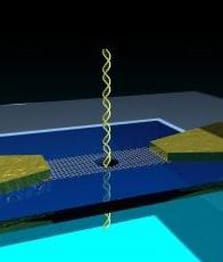MoS2 Paves Way for Improvements in Nanopore DNA Sequencing

Molybdenum disulfide has outclassed graphene as the material of choice for nanopore based DNA sequencing, with improved speed, cost and accuracy.
Researchers at Univeristy of Illinois in Champaign are reporting on a breakthrough in DNA sequencing using molybdenum disulfide (MoS2) nanopores. The researchers were able to sequence DNA more accurately, inexpensively and quickly than any other method currently in use or in development.
MoS2 has so far proved to be a wonder material that has been successfully used to make biosensors, photo detectors and event transistors. In new experiments it has proven to outperform all materials used until now for nanopore based DNA sequencing, even surpassing wonder material graphene.
The most notable difference between molybdennum disulphide and other materials is its one molecule thickness. Materials other than graphene used in nanopores are too thick to read the electric fluctuations of the DNA bases being driven through them. While grapheme is thin, one of its major flaws is the DNA sticking to the surface.
Molybdenum disulphide’s is similar in thickness to that of graphene, but does not stick to DNA and gives four clear signals for A, T, G and C. This is far more accurate than other nanopore based sequencers which yielded two signals at bests A/T and C/G. The Blue Waters Supercomputer at the University of Illinois was used for MoS2 simulation and analysis.
Read more about the research here.

